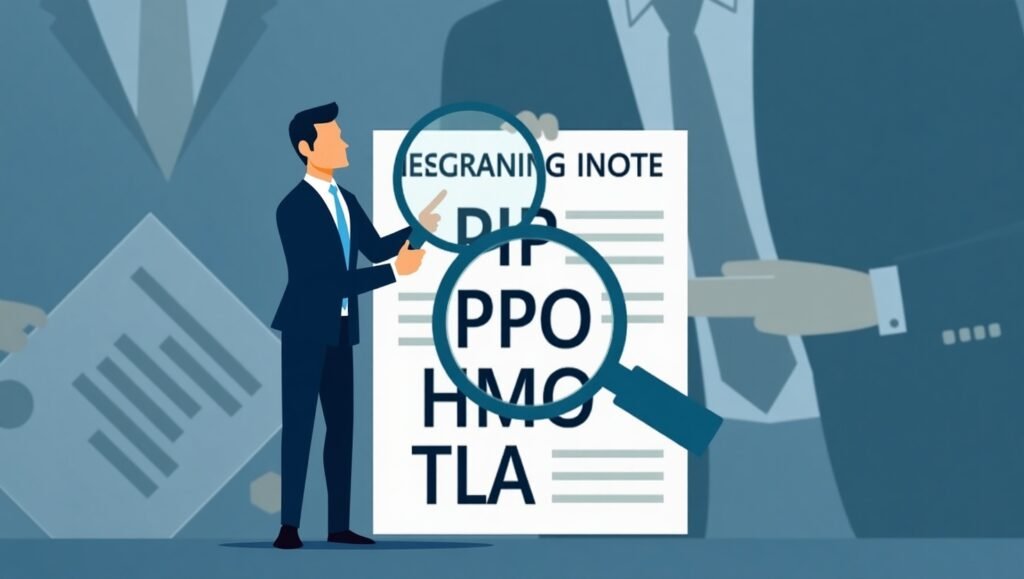Introduction
Insurance can feel like a whole different language, packed with abbreviations that leave you scratching your head. Ever seen terms like PIP, PPO, or HOI and had no idea what they meant? These little acronyms might look simple, but they carry a lot of weight when it comes to your insurance coverage.
If you’re looking to buy an insurance plan—whether it’s for life, health, auto, or home—understanding these big acronym in insurance will help you make better financial decisions. In this guide, we’ll break down the most important insurance acronyms so you can navigate policies like a pro.

What is the “Big Acronym in Insurance”?
Acronyms in insurance are shorthand for important terms used by companies to define coverage, premiums, and benefits. They help streamline communication but can also make things confusing for policyholders who aren’t familiar with them.
For example, when you see HMO, it stands for Health Maintenance Organization—a specific type of health insurance plan. Knowing these terms helps you compare policies effectively and ensures you’re getting the best coverage for your needs.
Key Insurance Acronyms You Must Know
Life Insurance Acronyms
TLA (Term Life Insurance)
This is a life insurance policy that provides coverage for a specific term (e.g., 10, 20, or 30 years). If the policyholder passes away during the term, beneficiaries receive a payout.
UL (Universal Life Insurance)
Unlike term life, universal life insurance offers both a death benefit and a cash value component that earns interest over time. It’s flexible, allowing policyholders to adjust their premiums.
WL (Whole Life Insurance)
This is a permanent life insurance policy that lasts a lifetime and builds cash value. It’s often more expensive but provides guaranteed benefits.
Health Insurance Acronyms
HMO (Health Maintenance Organization)
An HMO plan requires you to use a specific network of doctors and hospitals and get referrals from a primary care physician for specialist visits.
PPO (Preferred Provider Organization)
A PPO plan is more flexible than an HMO, allowing you to see any doctor without referrals—but at a higher premium.
HDHP (High Deductible Health Plan)
An HDHP has lower monthly premiums but higher out-of-pocket costs before insurance starts covering expenses.
Auto Insurance Acronyms
PIP (Personal Injury Protection)
This covers medical expenses and lost wages after an accident, regardless of who was at fault.
UM/UIM (Uninsured/Underinsured Motorist)
These coverages protect you if you get into an accident with a driver who has little or no insurance.
BIL (Bodily Injury Liability)
This covers injuries caused to others in an accident where you’re at fault.
Home Insurance Acronyms
HOI (Homeowners Insurance)
HOI covers your home and belongings from damage, theft, or disasters like fires and storms.
RCE (Replacement Cost Estimate)
This determines the cost to rebuild your home in case of damage.
ALE (Additional Living Expenses)
If your home becomes unlivable due to damage, ALE coverage helps pay for temporary living costs like hotel stays.

Why Insurance Acronyms Matter?
Understanding big acronym in insurance isn’t just about knowing fancy terms. It helps you:
✅ Choose the right policy for your needs
✅ Avoid overpaying for coverage you don’t need
✅ Ensure you’re fully protected in case of emergencies
How to Decode Insurance Jargon?
- Use insurance glossary tools online
- Ask your insurance agent to explain terms in plain language
- Compare policies side by side and read the fine print
Common Misconceptions About Insurance Acronyms
🚫 All policies are the same – Each plan offers different coverage based on the acronyms used.
🚫 Acronyms don’t affect costs – Some plans, like HDHP, can save you money but come with higher deductibles.
Tips for Choosing the Right Insurance Policy
🔹 Compare policies using acronyms as a reference
🔹 Ask questions to clarify what’s covered
🔹 Read customer reviews to see how companies handle claims
Conclusion
Decoding big acronym in insurance can feel overwhelming, but it’s essential for making informed decisions. Whether it’s PPO vs. HMO or TLA vs. WL, understanding these terms ensures you get the best coverage at the right price.
Now that you know what these acronyms mean, you can confidently choose an insurance policy that fits your needs!
First Alternative Car Insurance Reviews – A Comprehensive Guide 2025
FAQs
What does “big acronym in insurance” mean?
It refers to commonly used insurance abbreviations that define coverage, benefits, and costs.
How can I learn more about insurance terms?
Use online glossaries, ask your insurance provider, or read policy documents carefully.
Are insurance acronyms the same in every country?
No, acronyms can vary depending on the country and the insurance provider.
How do acronyms affect my premium costs?
Certain plans, like HDHP, have lower premiums but higher out-of-pocket costs.
Which insurance acronyms should I prioritize when choosing a policy?
Focus on acronyms that impact coverage limits, deductibles, and policy exclusions.

